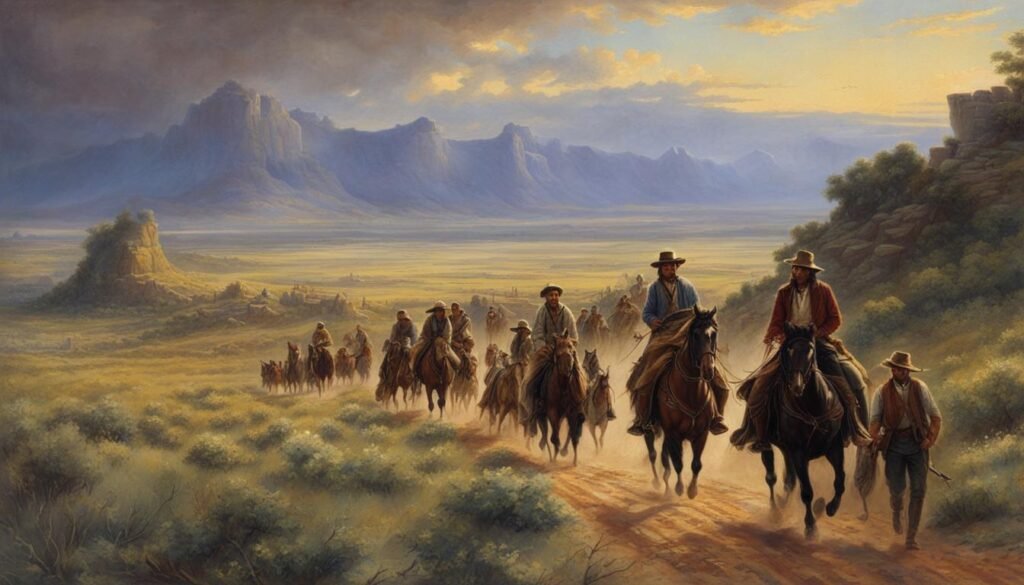The history of the United States is a fascinating journey through time, filled with countless stories of courage, determination, and the pursuit of freedom. From its humble beginnings as a collection of thirteen British colonies to its evolution into a nation of fifty states, the formation of the United States has shaped the course of world history.
It all started thousands of years ago, with the arrival of the first people in the Americas around 15,000 BC. Over time, indigenous cultures flourished, laying the groundwork for the rich tapestry of American history.
Fast forward to the late 15th century, when European explorers set foot on American soil, sparking a wave of colonization. The thirteen British colonies, strategically positioned along the Atlantic Coast, became the foundation for what would later become the United States.
An era of immense significance was the American Revolution, a pivotal moment in the country’s history. Fueled by a desire for self-governance and freedom from British rule, the American Revolution began in 1775. Led by visionary figures such as the Founding Fathers, the colonies declared their independence in 1776 with the signing of the Declaration of Independence. This iconic document laid the groundwork for the formation of a new nation.
The Revolutionary War, which followed the declaration, was a hard-fought battle for liberty. Finally, in 1783, the peace treaty was signed, officially recognizing the United States as a sovereign state and establishing its borders.
Key Takeaways:
- The United States was formed through a series of historical events, starting with the arrival of the first people in the Americas and leading to European colonization.
- The American Revolution and the signing of the Declaration of Independence marked a turning point in the country’s history, leading to the establishment of a new nation.
- The United States expanded westward, driven by the concept of manifest destiny, and went through a period of significant growth and development.
- The Civil War and Reconstruction era brought about important social and political changes, notably the abolition of slavery.
- Understanding the history of the United States is essential to grasp the country’s complexities and achievements throughout its early years.
The American Revolution and the Birth of the United States
The American Revolution, also known as the War of Independence, was a pivotal moment in early American history. It was a conflict between Great Britain and its thirteen North American colonies that began in 1775 and concluded in 1783. The revolution was fueled by various factors, including discontent with British rule, taxation without representation, and the desire for self-governance.
The courageous colonists, led by the visionary Founding Fathers, took a bold step towards freedom by declaring their independence from Britain on July 4, 1776. This momentous event was marked by the signing of the Declaration of Independence, a document that laid out the values and principles upon which the United States was founded.
The Revolutionary War followed, as the American colonies fought for their autonomy and the right to govern themselves. It was a long and arduous conflict, spanning several years, but through determination and perseverance, the United States emerged victorious. The war’s end in 1783 solidified the birth of a new nation and established the United States as a sovereign entity.
The American Revolution set the stage for the creation of a new government system that would ensure the freedoms and rights of its citizens. This system ultimately culminated in the adoption of the American Constitution in 1789. The Constitution outlined the structure of the government and provided a framework for the governance of the United States, reflecting the principles and ideals fought for during the Revolutionary War.
This pivotal period in American history laid the foundation for the nation we know today. It was a time marked by courage, ambition, and a deep desire for freedom and self-determination. The American Revolution and the birth of the United States serve as a testament to the resilience and spirit of the American people, as well as the enduring legacy of the Founding Fathers.

Expansion and Westward Movement
After the formation of the United States, a period of expansion and westward movement began, shaping the early history of the country. From the original thirteen colonies, the United States eventually expanded to encompass fifty states.
This expansion was driven by the idea of manifest destiny, the strong belief that it was the country’s destiny and right to expand its territory from coast to coast. As settlers ventured westward, conflicts with Native American tribes, known as the Indian Wars, emerged.

In 1803, the United States acquired the Louisiana Territory from France through the Louisiana Purchase. This acquisition doubled the size of the country and opened up vast opportunities for further westward expansion.
The concept of homesteading encouraged individuals and families to settle in the American West, with the goal of cultivating and developing the land. Homesteaders faced numerous challenges, but their efforts contributed to the growth and development of the United States.
Key Events:
- Manifest Destiny: The belief that the United States had the divine right to expand its territory from the Atlantic to the Pacific.
- Indian Wars: Conflicts and battles between settlers and Native American tribes as the country moved westward.
- Louisiana Purchase: The acquisition of the Louisiana Territory from France, effectively doubling the size of the United States.
- Homesteading: The encouragement and promotion of settling and cultivating land in the American West.
The expansion and westward movement of the United States played a significant role in shaping the country’s history, economy, and culture. It solidified the notion of the United States as a continental nation, stretching from the Atlantic Ocean to the Pacific Ocean.
The Civil War and Reconstruction
The United States faced significant challenges during the Civil War Era, a period from 1849 to 1865. One of the main issues that divided the nation was the institution of slavery. This led to the outbreak of the Civil War in 1861, with the Northern states (Union) fighting against the Southern states (Confederacy) over the issue of slavery.
The Civil War was a devastating conflict that had a profound impact on the nation. It resulted in the loss of countless lives and brought about significant social and political changes. Ultimately, the Union emerged victorious, and the institution of slavery was abolished with the adoption of the Thirteenth Amendment in 1865.
The end of the Civil War marked the beginning of the Reconstruction Era, which aimed to rebuild the country and address the rights of newly freed African Americans. During this period, efforts were made to establish a more inclusive and equitable society. One of the key milestones was the Emancipation Proclamation, issued by President Abraham Lincoln in 1862, which declared the freedom of slaves in Confederate states.
However, the progress of Reconstruction was hindered by the rise of Jim Crow laws and racial discrimination, particularly in the Southern states. These laws enforced segregation and denied African Americans basic civil rights. The implementation of Jim Crow laws presented further challenges for African Americans, keeping them in a state of inequality and oppression for many years to come.
The Civil War and Reconstruction era left a lasting impact on the United States. It highlighted the deep divisions within the country and the struggle for equality and justice. The abolishment of slavery and the efforts towards Reconstruction marked important milestones in the ongoing fight for civil rights and social progress for all Americans.
Conclusion
The early history of the United States is a tapestry woven with various historical events and periods that shaped the nation into what it is today. From the arrival of the first people in the Americas to the European colonization and the American Revolution, the United States underwent significant transformations.
The expansion and westward movement played a pivotal role in defining the geographic and cultural diversity of the United States. The country grew from a collection of thirteen British colonies along the Atlantic Coast to fifty states that span from coast to coast. This westward movement, driven by the concept of manifest destiny, shaped the American West and encouraged the settlement of new territories.
The Civil War and Reconstruction era brought about profound social and political changes. The abolition of slavery, marked by the Emancipation Proclamation and the Thirteenth Amendment, was a significant turning point in United States history. However, the challenges and struggles faced during the Reconstruction era and the rise of Jim Crow laws showcased the continuous fight for equality and civil rights, particularly for African Americans.
Understanding the early history of the United States is crucial to comprehend the complexities and achievements that have shaped the nation. The story of the American colonies, the Revolutionary War, the expansion westwards, and the fight for equality and freedom provides the foundation for the United States’ diverse society and its enduring values of liberty and democracy.
FAQ
How was the United States formed?
The United States was formed through a historical process that involved the arrival of the first people in the Americas, European colonization, the American Revolution, and the adoption of the American Constitution.
What was the American Revolution?
The American Revolution, also known as the War of Independence, was a conflict between Great Britain and its thirteen North American colonies. It began in 1775 and ended in 1783, resulting in the formation of the United States of America.
How did the United States expand westward?
The United States expanded westward through a period of exploration and settlement known as manifest destiny. This expansion led to the growth of the original thirteen colonies into fifty states and was driven by factors like the Louisiana Purchase, homesteading, and conflicts with Native American tribes.
What was the Civil War and Reconstruction?
The Civil War was a conflict fought between the Northern and Southern states from 1861 to 1865 over the issue of slavery. The war ended with the victory of the Northern states and the abolition of slavery. Reconstruction was the period after the Civil War aimed at rebuilding the country and addressing the rights of newly freed African Americans.
What is the significance of early American history?
Early American history is significant as it laid the foundation for the nation’s values of liberty and democracy. It shaped the cultural and geographic landscape of the United States and shaped the history of America from its colonial beginnings to its emergence as a global superpower.







